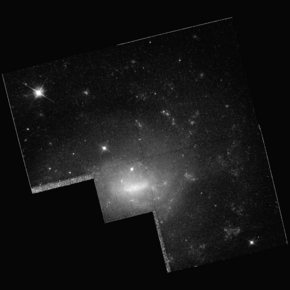| NGC 5774 | |
|---|---|
 NGC 5774 (NASA/ESA HST) | |
| Observation data (J2000.0 epoch) | |
| Constellation | Virgo |
| Right ascension | 14h 53m 42.46s [1] |
| Declination | +03° 34′ 56.96″ [1] |
| Redshift | 0.005187 [1] |
| Heliocentric radial velocity | 1555 ± 2 km/s [1] |
| Distance | 71 Mly[1] |
| Apparent magnitude (V) | 12.30 [2] |
| Apparent magnitude (B) | 13.00 [2] |
| Characteristics | |
| Type | SAB(rs)d [1] |
| Apparent size (V) | 1.9 x 1.12 [1] |
| Other designations | |
| PGC 53231, MCG 1-38-13, UGC 9576 | |
NGC 5774 is an intermediate spiral galaxy approximately 71 million light-years away from Earth in the constellation of Virgo.[1] It was discovered by Irish engineer Bindon Stoney on April 26, 1851.[3]
NGC 5774 belongs to the NGC 5775 Group of galaxies—together with nearby NGC 5775, IC 1070, and others—which is part of the Virgo III Groups strung out to the east of the Virgo Supercluster of galaxies.[4][5] It has been classified as a "low surface brightness" (LSB) galaxy, but its central surface brightness is 5 times brighter than the brightest LSB galaxies.[5][6] It has a multiple spiral pattern with bright blue knotty structure all along the arms.[7]
It is an extremely low star forming galaxy with five X-ray sources plus three ultraluminous X-ray source candidates.[8]
- ^ a b c d e f g h Cite error: The named reference
Databasewas invoked but never defined (see the help page). - ^ a b Cite error: The named reference
sedswas invoked but never defined (see the help page). - ^ Cite error: The named reference
astronomy-mallwas invoked but never defined (see the help page). - ^ "The Virgo III Groups". Atlas of the Universe. Retrieved 2010-11-27.
- ^ a b Cite error: The named reference
Cambridgewas invoked but never defined (see the help page). - ^ Cite error: The named reference
Irwinwas invoked but never defined (see the help page). - ^ Cite error: The named reference
Database-noteswas invoked but never defined (see the help page). - ^ Ghosh, Kajal K.; et al. (2009). "Multiwavelength study of the bright X-ray source population in the interacting galaxies NGC 5774/NGC 5775". The Astronomical Journal. 137 (2): 3263–3285. arXiv:0810.5393. Bibcode:2002ApJ...566..667R. doi:10.1088/0004-6256/137/2/3263. S2CID 14007174.